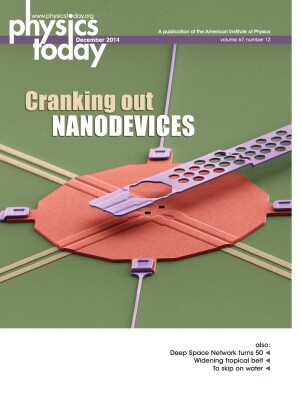Modeling a virus atom by atom
DOI: 10.1063/PT.3.2608
Although atoms and molecules are quantum mechanical objects, their movement can often be well simulated using classical physics, with empirical potential energy functions to describe the forces exerted on each atom by its neighbors. Such molecular dynamics calculations have long been performed on proteins containing thousands of atoms (see Physics Today, December 2013, page 13
Shown in the figure, the capsid comprises 240 protein molecules arranged in an icosahedrally symmetric structure. Normally, the capsid is packed with the virus’s genetic material, but natural virus samples also include some capsids that are filled with nothing but water. To include enough water molecules in their simulations to fill and surround the capsid, Okazaki and colleagues needed to model the dynamics of nearly 6.5 million atoms, which they did for a simulated 200 ns.

Making the best use of the K computer’s 80 000 parallel processors was a challenge. It’s not easy to divide a large molecular dynamics simulation into so many independent calculations, because long-range electrostatic interactions mean that the dynamics of distant regions of space can be highly intertwined. Okazaki and colleagues developed a program to implement a fundamentally new way of calculating those long-range forces: by dividing the simulated space into cells and treating all the atoms in each distant cell as a series of multipoles. 2 That approach, which they call the fast multipole method, limits the need for communication between processors and allows the K computer to calculate tens of nanoseconds of simulation time per day. The same calculation on a conventional supercomputer would take more than a year.
Poliovirus isn’t the largest viral system to be tackled by molecular dynamics. Last year, Peijun Zhang, Christopher Aiken, Klaus Schulten, and their colleagues reported a simulation of the human immunodeficiency virus-1 capsid and its watery environment, a total of 64 million atoms. 3 The purpose of that calculation was to help pin down the HIV-1 capsid’s structure. In contrast, the Nagoya researchers sought to understand the poliovirus’s behavior.
Okazaki and colleagues found that water molecules moved easily into and out of the capsid, but curiously, simple salt ions (sodium, potassium, and chloride) did not. Another surprising result was that the pressure of the water inside the capsid was strongly negative—that is, the water was under tension. In bulk systems, negative pressures are unstable to the formation of vapor bubbles. But the critical size for bubble formation is about 100 nm, five times the capsid’s inner diameter.
The permeability to water could help to account for the capsid’s resilience to high external pressures, including shock waves, but also its vulnerability under other conditions, such as desiccation. And although the negative pressure tends to destabilize the empty capsid, it could also help the capsid more stably accommodate its RNA. For Okazaki and his team, the calculations so far are just the first step. They hope that continued simulations will help them understand the molecular mechanisms of viral infection. They also hope to discover a way to stabilize the empty poliovirus capsids for use in polio vaccines.
References
1. Y. Andoh et al., J. Chem. Phys. 141, 165101 (2014). https://doi.org/10.1063/1.4897557
2. Y. Andoh et al., J. Chem. Theory Comput. 9, 3201 (2013). https://doi.org/10.1021/ct400203a
3. G. Zhao et al., Nature 497, 643 (2013). https://doi.org/10.1038/nature12162
